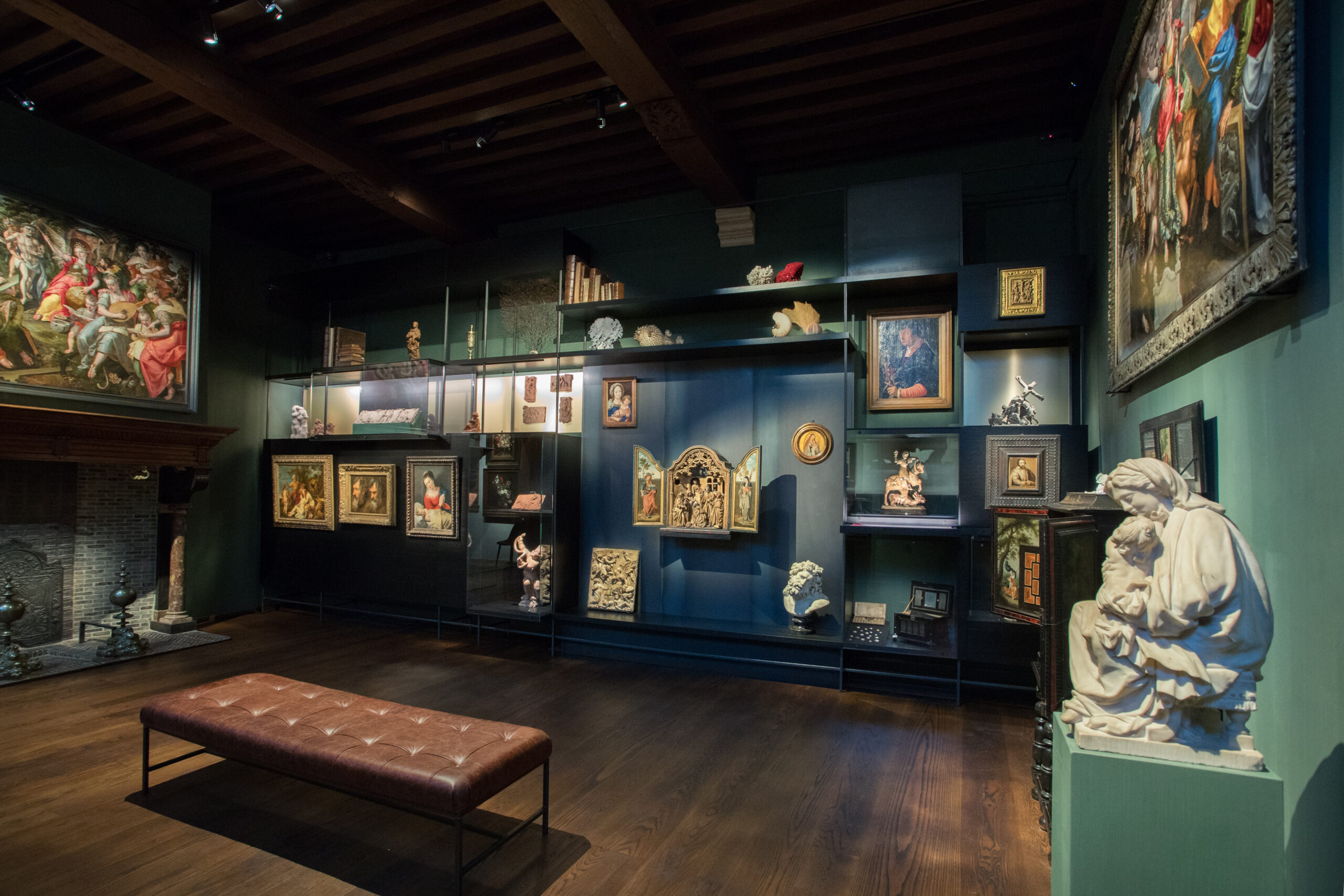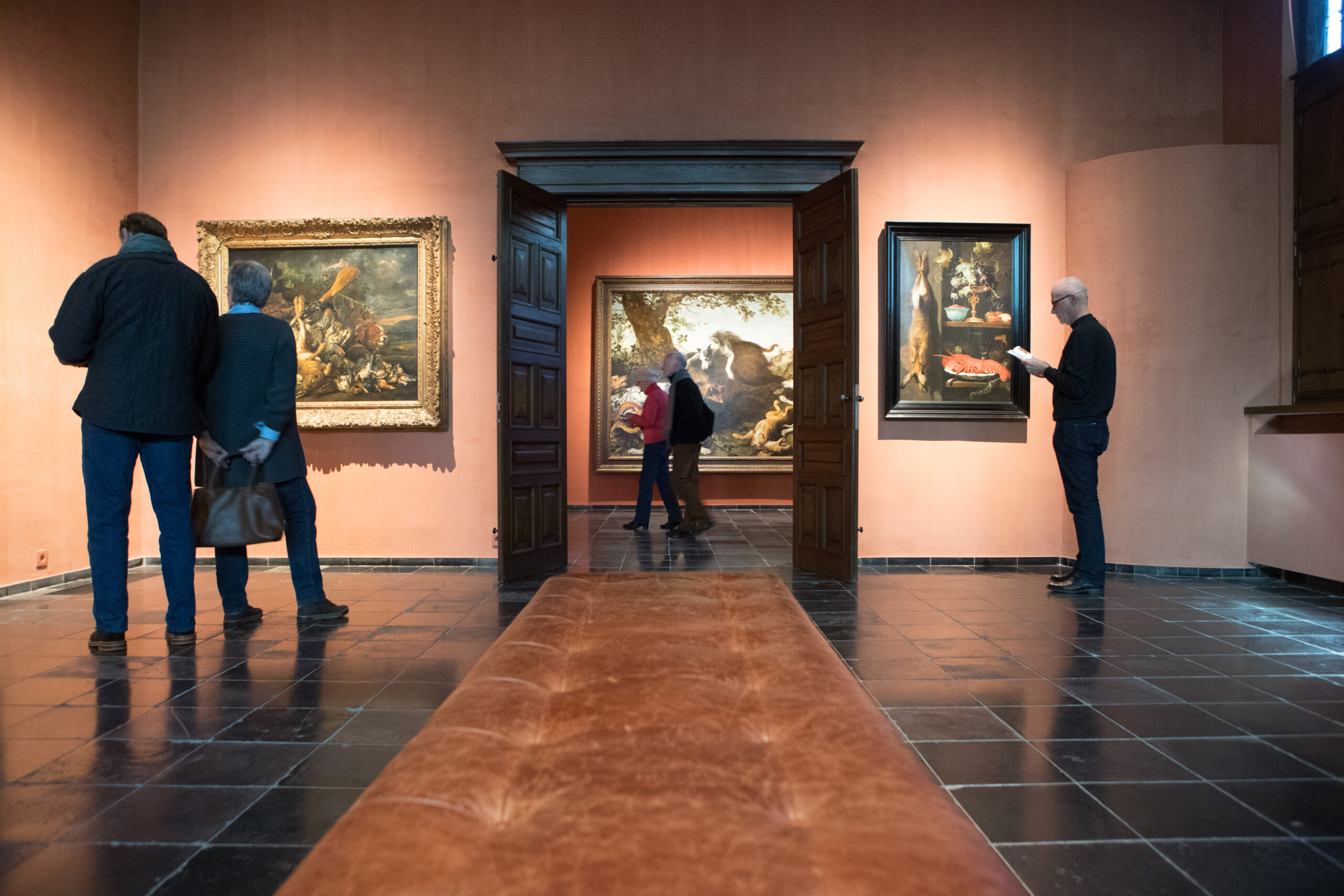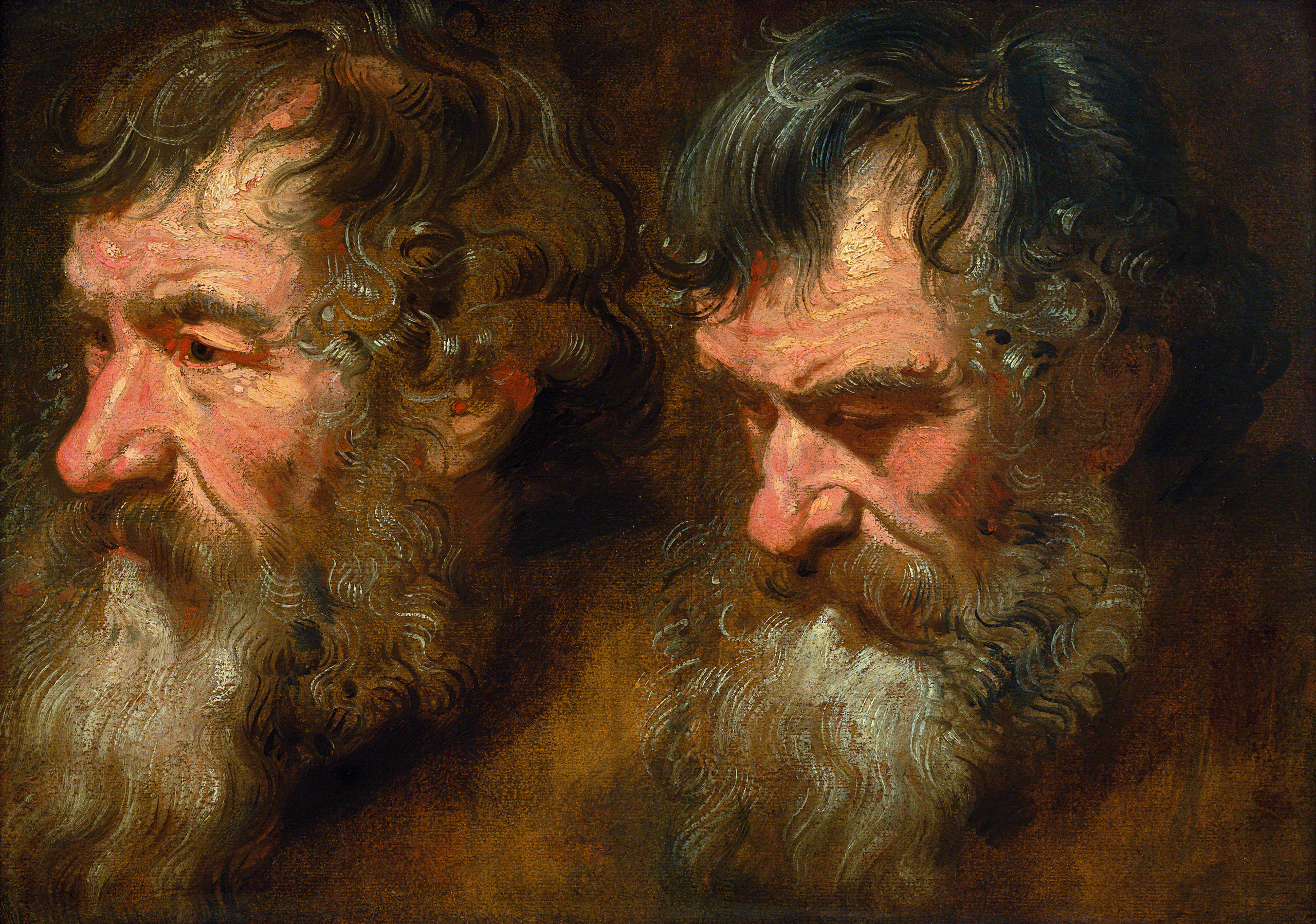As curator of the Snijders&Rockox House in Antwerp, it is an honor to be able to introduce myself on behalf of our museum. I was born in Ghent, which bears the stamp of Jan van Eyck to this day. Art has never suffered from a lack of attention here, from his time right down to our own. Ghent is a lovely city with a highly regarded university. Its art history department is located at the foot of the famous ‘Book Tower’ designed by the celebrated architect Henry van de Velde – not an ancestor of mine, sad to say, but an artist for whom I have great admiration. Indeed, the proximity of his work provided me with an added incentive to study art history in my home town. I went on to take a master’s degree in documentation and library studies at Antwerp University.

Hildegard Van de Velde and a portrait of Nicolaas Rockox by Thomas Willeboirts Bosschaert of 1641, long term loan of Maagdenhuismuseum, Antwerp
I have been curator of the Rockox House – now the Snijders&Rockox House – since 2001. My responsibilities include caring for the modern art collection of KBC Bank, which owns our splendid double museum. We received the Flemish Community’s quality label in 2009 and are fully ICOM compliant.
The history of the institution as we know it today has its origins in 1977, the year of a major Rubens anniversary, during which the Rockox House was partially opened to the public as a museum. Since 2018, the building has been thoroughly restored and the focus of our presentation has shifted. Meanwhile, the adjacent property, the former home of the artist Frans Snijders, has also been converted into a museum. The resulting Snijders&Rockox House – residences of two of Antwerp’s most noteworthy public figures from the first half of the seventeenth century – functions as a single museum. It also serves as an inspiring and edifying meeting place, where visitors can experience art and history in the Baroque city of Antwerp in an innovative way.
The Snijders&Rockox House, the historical residences, and the art collection they host, are the point of departure for a dialogue with the community and heritage of Antwerp in the rough period 1550–1650. Several of Antwerp’s museums are linked to key figures from that period. In our case they are Burgomaster Nicolaas Rockox and the painter Frans Snijders. With his strong commitment to social and political causes, Rockox is an emblem of leadership, image management, networking, and enterprise. His cultural achievements were similarly remarkable: as a patron of artists including Peter Paul Rubens, Rockox played an exemplary role in promoting his city’s art. Frans Snijders was a craftsman who embodied creativity, excellence, and the spirit of cooperation. By drawing on this rich past, our museum remains innovative while conveying a compelling narrative to a wide audience. We combine tangible and intangible evidence to provide a fresh and engaging presentation.
As the manager of the KBC collection, I can draw on the bank’s logistical network and facilities, while also working within its Communications Department. I am therefore well placed to seek out partners for collaboration in the world of art history. It all makes for a fascinating experience, not to mention an ongoing education in a wide range of subjects. Constructive working relationships are the order of the day in Antwerp and we regularly team up with other historical residences such as the Vleeshuis, Plantin-Moretus, Maagdenhuis and Mayer van den Bergh Museums – and naturally the Rubens House. I am currently working on a show Keyboard Instruments – Virginals, Harpsichords and Organs Depicted in the 16th and 17th Centuries, which means close cooperation with the Vleeshuis – the museum with the world’s richest collections of virginals and harpsichords. It is thanks to the Vleeshuis that the Snijders&Rockox House has had a fully-fledged music room since 2018. The exhibition will be displayed at both museums and we are collaborating on a catalogue. Keep an eye on the CODART calendar for this prestigious project, which is due to open at the end of March.
We organize an exhibition every year – as a relatively small museum, rekindling interest on a regular basis is essential. Each show is inspired by the collection and thus complements the permanent display. In 2020, the museum collaborated with the Phoebus Foundation and other Antwerp institutions to stage a large-scale portrait exhibition, Blind Date, on the rich Northern and Southern Netherlandish portraiture of the fifteenth to seventeenth centuries. In 2019 I was privileged to work alongside the eminent researchers Dr Teréz Gerszi and Dr Louisa Wood Ruby on an exhibition of Jan Brueghel’s drawings at the Snijders&Rockox House. It was the first time this part of Brueghel’s oeuvre had been examined in its entirety and the two scholars’ catalogue was immediately hailed as a standard work. In 2018, the City of Antwerp teamed up with Tourism Flanders under the banner Baroque: Rubens Inspires. Our museum invited the photographer Tony Leduc to produce a series of images inspired by the paintings of Frans Snijders. The result was a fascinating dialogue between past and present, and two branches of art, marked by a striking similarity in their acute observation of the same subject matter: the presentation of foodstuffs.
The KMSKA is due to reopen in Antwerp next year. Between 2013 and 2017, we had the honor of hosting some of its works. In the course of those four years, 120 paintings ranging in dates from the Middle Ages to the seventeenth century made the short journey from the KMSKA to the much smaller Rockox House. Devising the appropriate temporary remodeling was a fascinating exercise for both institutions. The Golden Cabinet, as we called this exceptional match-up of artworks, focused on the collecting of art. The initiative also provided the perfect opportunity to publish a book on 500 years of collecting in Antwerp, to which I gladly contributed, along with ten other authors. The collaboration between our museums led to seven other temporary exhibitions, each with its own catalogue.
As the curator of a small museum, I am involved in every aspect of operations, down to the smallest detail. From conservation and restoration to public outreach and organizing exhibitions, and from communication to acquisitions and scholarship, including the cataloguing and description of the collection. I am fortunate to work in a wonderful setting where I can enjoy the beauty of the past every day. So it’s no easy matter to name my favorite work of art. Not least because a domestic museum like the Snijders&Rockox House is home to so many different genres: besides paintings, we have sculptures, furniture, coins, glass, silver, copper, bronze, ceramic, porcelain, alabaster, and marbleware. It was the totality of these striking objects that shaped the atmosphere of sixteenth and seventeenth-century Antwerp. If forced to single out just one, I would have to choose an early oil sketch by Anthony van Dyck. This study of a man’s head is a fantastic work – an exceptional tronie that confirmed the emerging genius of the young Van Dyck. The features in the portrait recur in several of his later paintings. The sketch spent last year on loan at the Van Dyck exhibition at the Alte Pinakothek in Munich.
The majority of KBC’s collection of fifteenth to eighteenth-century art is shown at the Snijders&Rockox House: some 800 items in all. Having opted for a clear narrative line at the museum, we rely on long-term loans to fill any gaps, for which I am immensely grateful to many colleagues at museums and private collections in Belgium and abroad. It means we update the collection on an annual basis, with quite a number of works entering and leaving the museum. The same goes for items from our own collection, which we are eager to share with solid projects, where the presentation is in keeping with our conservation and exhibitions policy. We like to think that we too are contributing in this way to responsible collection mobility.
One of the most enjoyable parts of our job is looking forward to the next annual CODART congress – something we have sadly missed lately. Each event is a feast of art as well as a reunion with colleagues and friends. While we wait – hopefully not too long – for the next one, I would like to end by thanking CODART for the amazing work it does, which is so crucial to every one of us.
Hildegard Van de Velde is curator at the Museum Snijders&Rockoxhuis. She has been a member of CODART since 2012.



